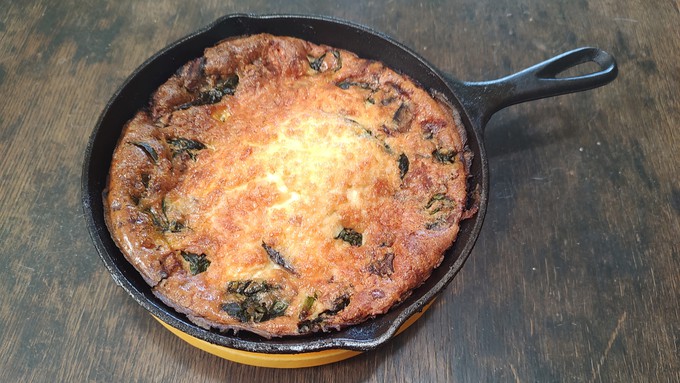
Recipe: Spinach-mushroom-pancetta frittata for breakfast, lunch or dinner

An 8-inch cast-iron skillet is ideal for making this spinach-mushroom-pancetta frittata. Debbie Arrington
Frittatas – Italy’s answer to the omelet – can be cooked on top of the stove or baked in the oven. I prefer to do a little of both – starting the frittata on a burner, then finishing it at 375 degrees for a golden brown finish.
That means using an ovenproof pan that can take the heat either way. An 8-inch cast-iron skillet is ideal.
Pancetta adds an earthy saltiness to the mushrooms and spinach in this anytime frittata, which can be an entree for breakfast, lunch or dinner. (Chopped bacon or ham can be substituted for the pancetta, or skip the meat altogether. Make sure the chopped bacon is cooked through before adding the egg mixture.)
I grow my spinach in pots so I can move it out of the scorching sun in summer. But heat-resistant New Zealand spinach will work in this recipe, too.
Spinach-mushroom-pancetta frittata
Serves 2 to 4
2 tablespoons butter
1 cup mushrooms, sliced
¼ cup onion, chopped
½ cup pancetta, diced
2 cups spinach
5 large eggs
½ cup heavy cream
¼ teaspoon hot red pepper sauce
1 cup cheddar cheese, shredded
Preheat oven to 375 degrees F.
In an 8-inch ovenproof skillet over medium heat, melt butter. Saute mushrooms and onions until onions are soft. Stir in pancetta; saute until edges start to brown. Stir in spinach, one handful at a time, until wilted.
In a large bowl, beat eggs. Add cream and hot sauce. Fold in cheddar cheese.
Carefully pour egg-cream mixture into the pan over the spinach-mushroom-pancetta mixture. With the handle of a wooden spoon, gently swirl contents of the pan so the filling ingredients mix with the eggs.
Transfer the pan to a 375-degree oven and bake for 25 to 30 minutes or until the top is golden brown and a thin-bladed knife inserted near the center comes out clean.
Remove from oven and let rest 5 minutes before serving.
Serve warm or at room temperature.
Comments
0 comments have been posted.Sacramento Digs Gardening to your inbox.
Sites We Like
Garden Checklist for week of July 21
Your garden needs you!
* Keep your vegetable garden watered, mulched and weeded. Water before 8 a.m. to reduce the chance of fungal infection and to conserve moisture.
* Feed vegetable plants bone meal, rock phosphate or other fertilizers high in phosphate to stimulate more blooms and fruiting. (But wait until daily high temperatures drop out of the 100s.)
* Don’t let tomatoes wilt or dry out completely. Give tomatoes a deep watering two to three times a week.
* Harvest vegetables promptly to encourage plants to produce more. Squash especially tends to grow rapidly in hot weather. Keep an eye on zucchini.
* Pinch back chrysanthemums for bushy plants and more flowers in September.
* Remove spent flowers from roses, daylilies and other bloomers as they finish flowering.
* Pinch off blooms from basil so the plant will grow more leaves.
* Cut back lavender after flowering to promote a second bloom.
* It's not too late to add a splash of color. Plant petunias, snapdragons, zinnias and marigolds.
* From seed, plant corn, pumpkins, radishes, winter squash and sunflowers.